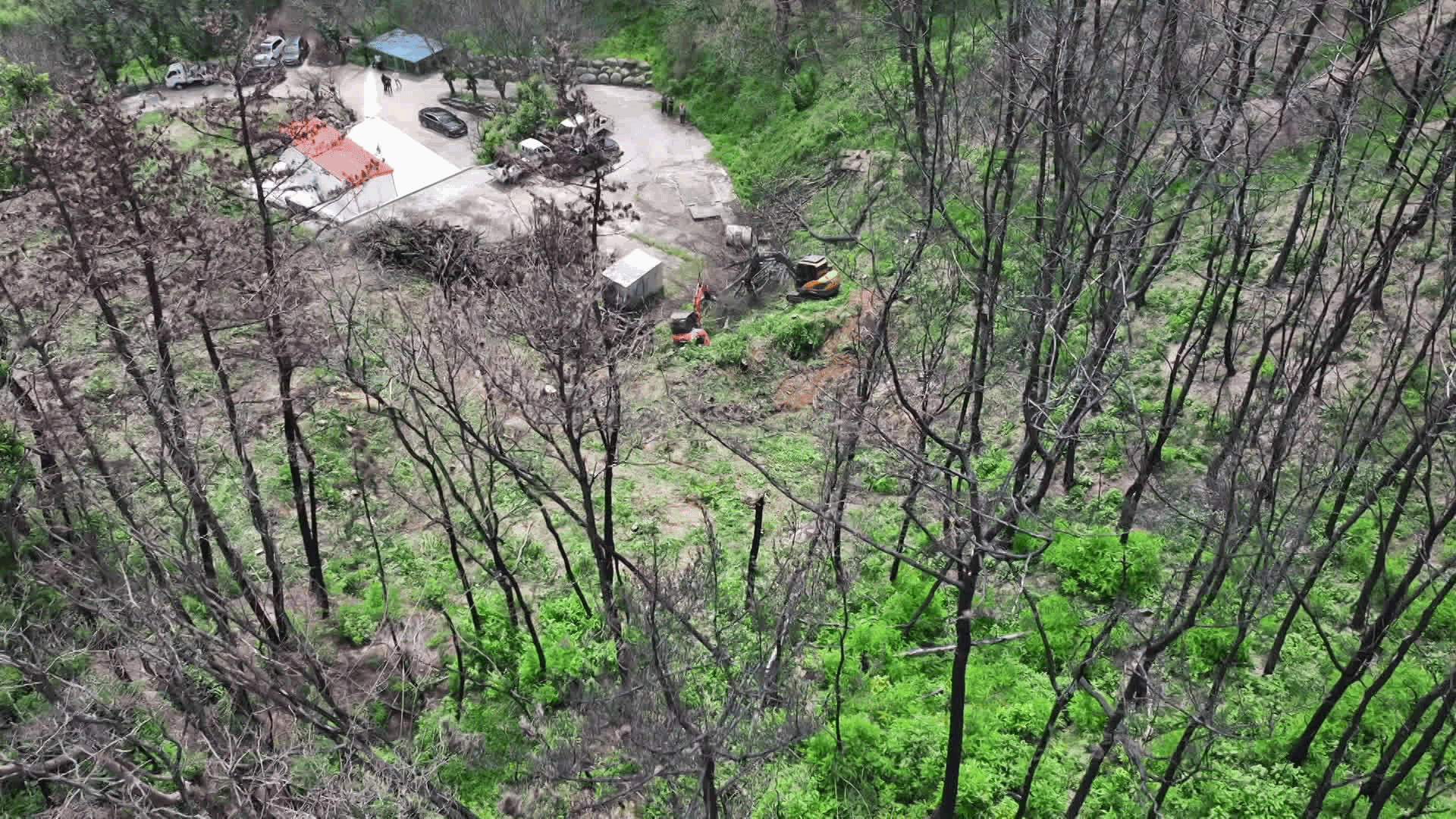[Anchor]
In areas ravaged by large wildfires, 'fire-damaged trees' also occur on a large scale.
After a certain period, they can no longer be used as timber, but they are also not easy to cut down.
Why is that? Reporter Lee Se-heum has investigated.
[Report]
Trees that have died due to the wildfire are being cut down to prevent them from falling on homes or roads.
The trees that are being logged for safety reasons are only a small portion of the fire-damaged trees.
Most of the trees remain charred from the massive wildfire that occurred in early March.
The situation is similar in Uljin, Gyeongbuk, where a large wildfire occurred three years ago.
Of the 16,000 hectares affected by the wildfire, only about one-fifth of the damaged trees have been logged.
Fire-damaged trees must be cut down within 1 to 2 years to maintain their strength and reduce warping, which preserves their value as timber.
[Park So-young/Director of Uljin National Forest Management Office: "In the first year after the wildfire, the trees did not fall or break, but now the trees are significantly decaying, and since decomposition is progressing, it is unfortunate, but it is difficult to utilize the trees that have been cut down now."]
The delay in logging is due to the lack of proper places to store or process the damaged trees even if they are logged.
[Lee Byeong-du/Head of Forest Disaster Environment Research Department, National Institute of Forest Science: "There are 104,000 hectares of wildfire damage, which is five times the area that our country harvests annually..."]
The fact that over 90% of the damaged forests are private land is also a hindrance.
It is difficult to obtain logging consent as the landowners are divided among several individuals.
Additionally, the soil damage caused by heavy machinery for logging and the voices of environmental groups advocating for the natural restoration of the wildfire-affected areas are also burdensome.
This is KBS News, Lee Se-heum.
In areas ravaged by large wildfires, 'fire-damaged trees' also occur on a large scale.
After a certain period, they can no longer be used as timber, but they are also not easy to cut down.
Why is that? Reporter Lee Se-heum has investigated.
[Report]
Trees that have died due to the wildfire are being cut down to prevent them from falling on homes or roads.
The trees that are being logged for safety reasons are only a small portion of the fire-damaged trees.
Most of the trees remain charred from the massive wildfire that occurred in early March.
The situation is similar in Uljin, Gyeongbuk, where a large wildfire occurred three years ago.
Of the 16,000 hectares affected by the wildfire, only about one-fifth of the damaged trees have been logged.
Fire-damaged trees must be cut down within 1 to 2 years to maintain their strength and reduce warping, which preserves their value as timber.
[Park So-young/Director of Uljin National Forest Management Office: "In the first year after the wildfire, the trees did not fall or break, but now the trees are significantly decaying, and since decomposition is progressing, it is unfortunate, but it is difficult to utilize the trees that have been cut down now."]
The delay in logging is due to the lack of proper places to store or process the damaged trees even if they are logged.
[Lee Byeong-du/Head of Forest Disaster Environment Research Department, National Institute of Forest Science: "There are 104,000 hectares of wildfire damage, which is five times the area that our country harvests annually..."]
The fact that over 90% of the damaged forests are private land is also a hindrance.
It is difficult to obtain logging consent as the landowners are divided among several individuals.
Additionally, the soil damage caused by heavy machinery for logging and the voices of environmental groups advocating for the natural restoration of the wildfire-affected areas are also burdensome.
This is KBS News, Lee Se-heum.
■ 제보하기
▷ 카카오톡 : 'KBS제보' 검색, 채널 추가
▷ 전화 : 02-781-1234, 4444
▷ 이메일 : kbs1234@kbs.co.kr
▷ 유튜브, 네이버, 카카오에서도 KBS뉴스를 구독해주세요!
- Fire damaged trees left uncut
-
- 입력 2025-08-19 04:02:00

[Anchor]
In areas ravaged by large wildfires, 'fire-damaged trees' also occur on a large scale.
After a certain period, they can no longer be used as timber, but they are also not easy to cut down.
Why is that? Reporter Lee Se-heum has investigated.
[Report]
Trees that have died due to the wildfire are being cut down to prevent them from falling on homes or roads.
The trees that are being logged for safety reasons are only a small portion of the fire-damaged trees.
Most of the trees remain charred from the massive wildfire that occurred in early March.
The situation is similar in Uljin, Gyeongbuk, where a large wildfire occurred three years ago.
Of the 16,000 hectares affected by the wildfire, only about one-fifth of the damaged trees have been logged.
Fire-damaged trees must be cut down within 1 to 2 years to maintain their strength and reduce warping, which preserves their value as timber.
[Park So-young/Director of Uljin National Forest Management Office: "In the first year after the wildfire, the trees did not fall or break, but now the trees are significantly decaying, and since decomposition is progressing, it is unfortunate, but it is difficult to utilize the trees that have been cut down now."]
The delay in logging is due to the lack of proper places to store or process the damaged trees even if they are logged.
[Lee Byeong-du/Head of Forest Disaster Environment Research Department, National Institute of Forest Science: "There are 104,000 hectares of wildfire damage, which is five times the area that our country harvests annually..."]
The fact that over 90% of the damaged forests are private land is also a hindrance.
It is difficult to obtain logging consent as the landowners are divided among several individuals.
Additionally, the soil damage caused by heavy machinery for logging and the voices of environmental groups advocating for the natural restoration of the wildfire-affected areas are also burdensome.
This is KBS News, Lee Se-heum.
In areas ravaged by large wildfires, 'fire-damaged trees' also occur on a large scale.
After a certain period, they can no longer be used as timber, but they are also not easy to cut down.
Why is that? Reporter Lee Se-heum has investigated.
[Report]
Trees that have died due to the wildfire are being cut down to prevent them from falling on homes or roads.
The trees that are being logged for safety reasons are only a small portion of the fire-damaged trees.
Most of the trees remain charred from the massive wildfire that occurred in early March.
The situation is similar in Uljin, Gyeongbuk, where a large wildfire occurred three years ago.
Of the 16,000 hectares affected by the wildfire, only about one-fifth of the damaged trees have been logged.
Fire-damaged trees must be cut down within 1 to 2 years to maintain their strength and reduce warping, which preserves their value as timber.
[Park So-young/Director of Uljin National Forest Management Office: "In the first year after the wildfire, the trees did not fall or break, but now the trees are significantly decaying, and since decomposition is progressing, it is unfortunate, but it is difficult to utilize the trees that have been cut down now."]
The delay in logging is due to the lack of proper places to store or process the damaged trees even if they are logged.
[Lee Byeong-du/Head of Forest Disaster Environment Research Department, National Institute of Forest Science: "There are 104,000 hectares of wildfire damage, which is five times the area that our country harvests annually..."]
The fact that over 90% of the damaged forests are private land is also a hindrance.
It is difficult to obtain logging consent as the landowners are divided among several individuals.
Additionally, the soil damage caused by heavy machinery for logging and the voices of environmental groups advocating for the natural restoration of the wildfire-affected areas are also burdensome.
This is KBS News, Lee Se-heum.
-
-

이세흠 기자 hmm@kbs.co.kr
이세흠 기자의 기사 모음
-
이 기사가 좋으셨다면
-
좋아요
0
-
응원해요
0
-
후속 원해요
0















이 기사에 대한 의견을 남겨주세요.